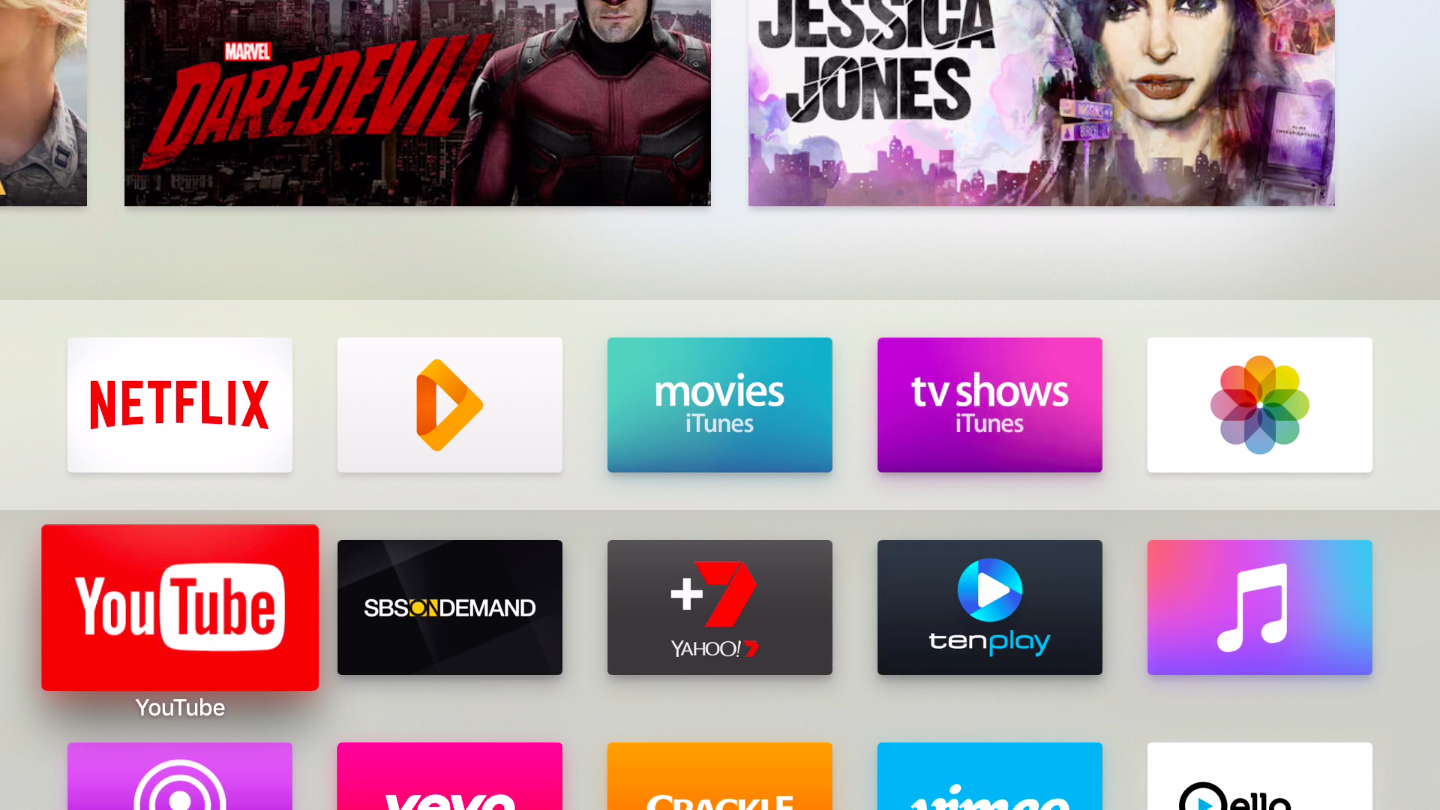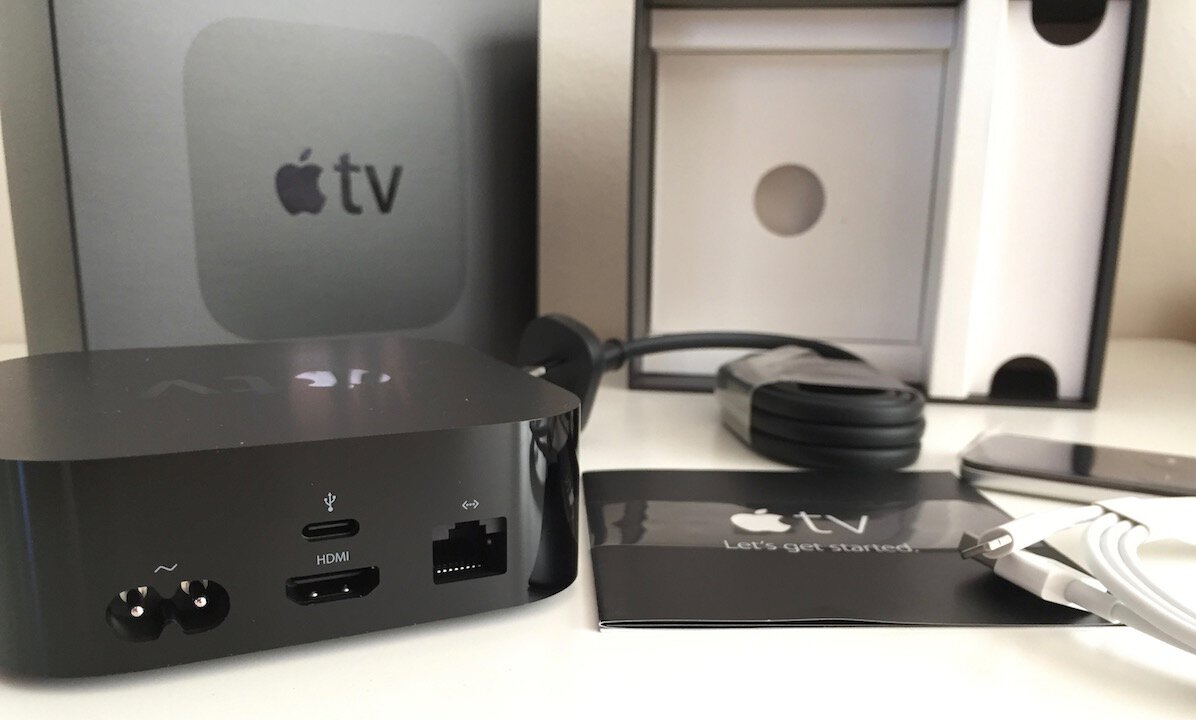Can the Apple TV 4 Make It As Our Primary Media Center?

- My Media History So Far
- Hardware Connection and Initial Setup
- Video Sources
- Power Consumption
- User Experience
- Conclusions
With an App Store now on the Apple TV, is the latest Apple TV 4 the ultimate media centre? I think it comes pretty darn close and here’s why.
My Media History So Far
I’ve wanted a simple to use device as a media centre for a while and so far the Apple TV 4 is ticking the boxes. With this device I have a solution that is flexible enough to play video from all sources that I use, has low power consumption and (so far) has good Wife Acceptance Factor.
Going back many years, my initial foray into a media centre was Windows XP Media Centre edition (running on a desktop PC) connecting from an Xbox 360 connected to the TV. As overly complicated as it was, it did allow me to record free-to-air TV and watch other media types; however since that time, the HD-DVD vs. Blu-ray war was fought and won, streaming media has become pervasive and LED TVs have become the norm.
Through that time, I’ve fought an ever frustrating battle with simplifying the way that we watch TV and movies (and to a lesser extend listen to audio).
I’ve had a Samsung smart TV since 2012; however from a usability perspective, it hasn’t held up when compared to newer devices. Our Sony Blu-ray player has “smart TV” functionality built into it as well, but this suffers from the same problems as the TV - slow to operate (although better than the TV) and a clunky interface, and I suspect a platform that’s effectively abandoned.
Both of these devices will stream TV and other streaming media solution, as well as from a NAS. They play various media types, but both choke on certain types of encoded video and just refuse to play or recognise others.
Finally, we don’t have our TV connected to the terrestrial aerial - it’s on the other side of the room and I couldn’t be bothered with attempting to get a coax cable through the wall. So, free-to-air TV is streamed via the TV or Blu-ray player
Apple TV 3
The Apple TV 4 has replaced our previous Apple TV 3. This previous model provided access to Netflix, iTunes, YouTube etc. but without an App Store, streaming TV was limited to one or two stations. Playing media from a NAS is possible; however to do that requires relying on AirPlay from an iPad / iPhone. Not an ideal solution.
Sticking with the Apple TV is then a simple choice for me given my history, we have several other Apple devices and a (minor) investment in iTunes media at this time.
Apple TV 4
It’s likely you’ve heard that Apple has released a new version of the Apple TV, which now boasts an App Store as well as real local storage options (32GB and 64GB). Although the new Apple TV loses the optical audio connection, the potential that a real app platform provides for flexibility in streaming practically any media made the new device appealing.
 >Apple TV 4 Unboxed
>Apple TV 4 Unboxed
From a hardware perspective, it’s not much different from the previous model. The new remote that comes with touch, a microphone and an accelerometer is very different though, and I’ll need to avoid losing or damaging it as a replacement is $129AU!
Hardware Connection and Initial Setup
I had the older Apple TV connected via HDMI and optical audio to the Blu-ray / surround sound system, which allowed me to use AirPlay for audio without having to turn the TV on. I’ve since replaced the audio function with a Sonos system.
The new Apple TV is now connected via HDMI to the TV, with the optical audio connecting the TV to the Blu-ray / surround sound system. Ultimately the optical audio will be connected to a Sonos soundbar.
The Apple TV 4 now supports HDMI-CEC. With the TV and Blu-ray player also supporting HDMI-CEC, turning on the Apple TV also turns on the TV and Blu-ray player, so to putting the devices to sleep. Additionally audio can be controlled from the Apple TV remote, which means I typically only need to reach for the TV or Blu-ray remote only very occasionally.
I use an ethernet cable for connection to the network as our router and NAS are all in the same location and I know I’m not going to have any transient network issues that I might get with WiFi.
The setup process was quite simple and I was up and running within a few minutes. Here’s a look at the first setup (I didn’t have a USB-C cable at the time, so resorted to taking photos of the process):
Video Sources
Today, we have a number of sources for video content that we typically watch on a large screen:
- Netflix - we’ve subscribed to Netflix for several years now and some of the Netflix Originals shows are great, e.g. Bloodline, Daredevil; however the content available in Australia isn’t as broad as it is in the US and the UK. The usability of Netflix app was better on the previous Apple TV, so I’m hoping this improves over time.
- iTunes - I still prefer Blu-ray media, but online sources such as iTunes, makes it simple to find new movies. If you’ve got young kids, the ability to watch something brand new at short notice, if you can’t stand watching Frozen for the 103rd time, is just fantastic. We also use iTunes to rent movies.
- Local video files - video ripped from DVD or downloaded via BitTorrent or other sources and stored on a NAS device
- Standard TV channels - we don’t watch free-to-air TV often, but the ABC (similar to the BBC or PBS) has great content for kids. The ABC iView app isn’t available for the Apple TV 4 yet, so this is the last app I’m waiting on to complete the media centre experience.
Most of the sources above are possible on the previous Apple TV; however local video sources wasn’t possible unless you used AirPlay. Now that the native platform has improved, apps such as Infuse or Plex make this possible natively.
4K Content
Apple haven’t made the new TV capable of 4K content and I would assume that this version of the device won’t ever be capable of it. Personally, I don’t see 4K content as being ready, at least in Australia. Until our new national broadband network is installed and more 4K content is made available, I’m not rushing out to get a 4K TV.
Things might be different in 18 months to 2 years and 4K TV will have then also reduced in price. In the meantime, I’ll wait for 4K to be more mainstream.
Power Consumption
The Apple TV 4 is an extremely low power device - one key decision for sticking with the Apple TV is the low power consumption both on stand-by and under load . I measured power consumption under various uses which shows impressive power draw:
- Home screen, no movement - 1.7 watts
- Home screen, navigating - 2.6 watts
- Netflix, streaming live action 1080p movie - 2.2 watts
- iTunes, streaming animated 1080p movie - 1.8 watts
- iTunes, streaming live action 1080p movie - 2.2 watts
- Infuse, streaming live action 1080p movie - 2.7 watts (the Synology DS212j that I’m streaming from pulls about 13.5 watts under normal load)
Ars Technica has a comparison table in their review of the Apple TV 4 from November 2015.

Device power consumption
Based on these numbers, I can’t imagine using an Xbox or PlayStation as a streaming device based on the cost to run it. Although I’m not suggesting you rush out to buy an Apple TV if you already have an Xbox or PlayStation.
User Experience
Here’s a few short videos that show the user experience across a number of scenarios (apologies for the audio buzzing, probably best to mute the videos). The home screen is still a standard grid style layout.
Using Siri makes avoiding text input easy. Here’s a couple of examples on searching for content.
The basic iTunes experience hasn’t changed much on the new device.
iTunes Movies on the Apple TV 4
Here’s a look at Infuse connecting to my NAS to browse movies I have stored there. Infuse is automatically recognising each video and applying cover photos and synopsis.
If you take a close look, you’ll notice that many icons will have a parallax effect on them as you move your finger around the touch pad on the remote.
Conclusions
Even though the App Store is still light, I’m unlikely to use the Apple TV as a gaming platform and the lack of 4K support, I’m very happy that it can play every video source that we use and it draw so little power doing so. So far it’s doing well as the primary device for all of our video content.
When it comes time to look at a new TV (probably with 4K support) any smart TV features will be superfluous. I need a large, high quality monitor, rather than a TV.
Although there are cheaper (and potentially more capable devices such as the Roku 4), the new Apple TV was a known quantity for me, so as an existing Apple user it’s an obvious choice. The only down side that I can see at this stage is the cost - this is not a cheap device, especially considering that the previous model was under $100US/£100. It does more, includes local storage and has an App Store, so depending on your requirements, the cost may not be an issue.
Other Uses
With AirPlay, the previous Apple TV models have been useful as remote displays in conference rooms (as long as you have an iPhone/iPad or MacBook).
An upcoming update to the Apple TV’s operating system (tvOS) will include the ability to connect Bluetooth keyboards. Along with 3rd party apps, the new Apple TV has potential to be a thin-client, much in the same way that Citrix Receiver works on iOS (the missing piece may be mouse support). It’s not likely to be used for general thin-client use, but for
So, the new Apple TV could become a more interesting device for conference room type use cases - it supports remote display of content via AirPlay as it always has plus it could serve a thin-client. With an App Store, I wonder if it’s possible for an app to support Miracast. With this, the Apple TV could also support remote display from Windows and Chromebook devices, making it very flexible indeed.
